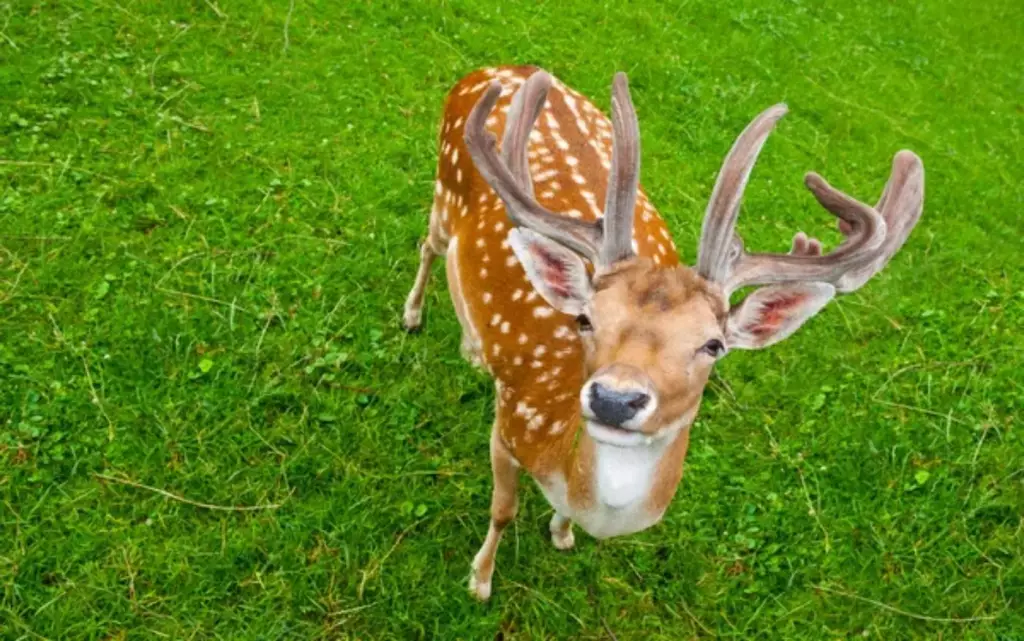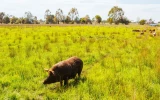Is Deer Farming Profitable? Is It Worth It?
Deer farming may seem niche, but it's a growing segment of agriculture that you might find intriguing. Unlike traditional livestock, deer offer a diverse revenue stream. In this article, we'll find out how profitable deer farming is and if it is worth managing these graceful animals.
Deer farming can be profitable, but its success depends on the location, market demand, species of deer farmed, and the scale of the operation. If a farmer can sell venison at $10 per pound and produce 10,000 pounds per year, that would result in $100,000 in revenue from meat alone.
However, besides meat, a deer farm has various potential revenue streams. Antlers, for example, can be lucrative for velvet extracts or as ornamental pieces. Let's take a closer look at other potential income sources that can come from deer farming.
Summary
- Starting a deer farm requires a significant initial investment, with costs such as land acquisition, fencing, shelter, and feeds amounting to an estimated total of $27,125 - $28,125 (excluding land and ongoing costs).
- The potential profit from deer farming can come from various sources such as selling venison, antler products, and breeding stock, with the estimated annual profit range varying greatly from $10,000 to over $200,000.
- Utilizing rotational grazing can improve soil health and extend pasture longevity while sourcing cost-effective feed alternatives like hay, ranging from $6 to $12 per bale, can significantly reduce off-season feed expenses.

On this page:
Profit Breakdown From Deer Farming
Cost considerations when starting a deer farm
| Initial Costs | Cost Estimate |
|---|---|
| Land | $500 - $10,000+/acre |
| Fencing | $18,625 |
| Feed/water | $3,000 |
| Shelter | $5,000 |
| Permits and licenses | $500 - $2,000 |
Land acquisition costs
Your first step in deer farming is acquiring suitable land. Remember, deer require space to roam, so the more acreage you have, the better. Land costs vary significantly by location and quality.
| Land Type | Price Range per Acre |
|---|---|
| Rural areas with less land demand | $500 - $3,000 |
| Desirable areas/urban proximity | $4,000 - $10,000 |
| Premium land with amenities | Over $10,000 |
Costs for fencing
Building strong fencing to contain deer and protect them from predators is essential. Perhaps consider 8-foot tall fences for security, with costs ranging based on materials used.
| Fencing Item | Estimated Cost |
|---|---|
| Roll of 8-foot fence | $365 |
| 10-foot T posts | $9/post |
| 3/8-inch pipe | $1.25/ft |
Costs for feed and water systems
Deer needs a consistent supply of feed, fodder, and hay, along with clean water. Installation of water tanks and year-round feeding are considerations for your budget. Feeds are considered to be one of the biggest costs to farmers.

Shelter and housing costs
While deer are resilient and can endure various weather conditions, providing some shelter can be beneficial for your herd's well-being, especially for fawn-rearing and during extreme weather.
Costs for permits
Permits and licenses in deer farming typically refer to the legal permissions and authorizations required to operate a deer farm.
These may include permits for breeding, transportation, and handling of deer, as well as licenses for the commercial sale of deer and deer products.
Additionally, there may be specific regulations regarding the fencing and containment of deer on the farm. Compliance with these permits and licenses is essential for ensuring the legal operation of a deer farming business and for maintaining the welfare and safety of the animals.
Keeping a deer in your farmland may also require you to apply for a CPH number.
| Ongoing Costs | Cost Estimate |
|---|---|
| Feed (operational cost) | $1,500 - $3,000 annually per deer |
| Breeding stock (operational cost) | $2,000 - $10,000+ |
| Health tests and veterinary care | $1,000 - $3,000 annually |
| Farm hands (under labor costs) | $25,000 - $50,000 annually |
| Management (under labor costs) | $30,000 - $60,000 annually |
| Transportation equipment | $2,000 - $10,000 |
| Handling facilities | $2,000 - $5,000 |
Operational costs
Operational efficiency in deer farming encompasses management, breeding, feeding, and handling practices that optimize health and nutrition, thus impacting profitability.
For instance, efficient feeding programs reduce costs and proper breeding management can boost birth rates and sales revenue.
| Operational Cost | Estimated Annual Cost per Deer |
|---|---|
| Feeding cost | $100 - $200 |
| Breeding cost | $50 - $150 |
Costs for health tests and veterinary care
Your deer farm must adhere to strict regulations set by the Department of Agriculture. Compliance often involves obtaining the necessary permits and conducting health testing for diseases like Tuberculosis, Brucellosis, and chronic wasting disease. Non-compliance can lead to fines or cessation of farm operations.
Required tests and permit costs:
- Tuberculosis test: Estimated cost per deer $15-$30
- Brucellosis test: Estimated cost per deer $20-$40
Labor costs
Whether you hire help or manage the farm yourself, account for labor costs in your financial plan.
Transport and handling costs
The cost of transport trucks or trailers for moving deer, as well as equipment like guillotine gates for easier handling, should be factored into your calculations.
Potential Revenue Streams From Deer Farming
In this section, we'll explore the different ways deer farms make money:
| Revenue Stream | Description | Estimated Potential Profit Range (Annually) |
|---|---|---|
| Selling venison | Based on market prices, operational efficiency, and herd size. Assumes a moderate-sized operation. | $10,000 - $100,000+ |
| Selling antler products | Depending on the quality and size of the antlers and the niche market demand. Assumes a small to medium-sized operation. | $5,000 - $50,000+ |
| Selling breeding stocks | Highly dependent on the genetic quality of the deer and market demand for breeding. Assumes a few high-quality sales per year. | $20,000 - $200,000 |
Profit from selling deer meat
Selling venison offers steady income, especially as demand for healthier, lean meat options increases.
Profit from selling antler products
Antlers can be sold for medicinal purposes or as decorative items, commanding high prices in niche markets.

Profit from selling breeding stocks
Deer farms can sell live animals to other farms or individuals looking to start or expand their own herds. Breeding stock can include does (female deer) and bucks (male deer) with desirable genetic traits.
Estimated profit for feer farming
Below is a simplified sample calculation of profit on your deer farm:
| Item | Estimated Cost Range |
|---|---|
| Annual maintenance | $1,000 - $5,000 |
| Venison per lb. | $7 - $20 |
| Antlers per set | $100 - $300 |
To compute for gross revenue, you can use the following formula:
- Revenue from venison: 1,000 lbs x $10/lb = $10,000
- Revenue from antlers: 20 sets x $200/set = $4,000
- Total gross revenue: $10,000 (venison) + $4,000 (antlers) = $14,000
To calculate for profits, take note of the following first:
- Maximum annual maintenance cost: $5,000
- Minimum annual maintenance cost: $1,000
Therefore, your potential profit range is as follows:
- Maximum profit: $14,000 (gross revenue) - $1,000 (minimum maintenance) = $13,000
- Minimum profit: $14,000 (gross revenue) - $5,000 (maximum maintenance) = $9,000
Therefore, your estimated profit range for the year would be between $9,000 and $13,000, depending on your actual maintenance costs.
Please note that this is a simplified calculation and does not take into account other potential costs or revenues, taxes, or the initial setup cost.
Calculating the profit margin from deer farming
Deer farmers are advised to aim for profit margins within 10% to 30%. To compute the profit margin, let's assume the following:
-
Total revenue from deer sales: $100,000
-
Direct costs (feed, veterinary care, labor, etc): $70,000
-
Overhead costs (maintenance, utilities, etc): $10,000
-
Profit = Total revenue - Direct costs - Overhead costs = $100,000 - $70,000 - $10,000 = $20,000
-
Profit margin = (Profit / Total Revenue) x 100 = ($20,000 / $100,000) x 100 = 20%
The profit margin for this deer farm would be 20%, which falls within the typical industry range of 10-30%.
Tips to Minimize Costs and Maximize Profits in Deer Farming
In deer farming, effectively managing your resources and ensuring the health of your herd is vital to your operation's success. Strategic facility design, informed breeding practices, and savvy marketing can substantially impact your profits.
Manage your resources
To ensure cost-efficiency, manage your pasture by conducting soil samples and supplementing with necessary minerals and vitamins.
You can use rotational grazing to maintain soil health and extend pasture longevity. During winter, consider cost-effective alternatives like hay or fodder to minimize feed expenses.
| Resource | Estimated Cost Range |
|---|---|
| Soil sample test | $30 - $100 per test |
| Mineral supplements | $10 - $25 per month/deer |
| Hay (Off-season) | $6 - $12 per bale |
Maintain herd health and welfare
Maintain your herd's health by providing clean water, a balanced diet rich in protein, and regular check-ups with a veterinarian to prevent diseases. Investing in the right care reduces long-term costs associated with the loss of animals and reduced breeding efficiency.
| Health Factor | Associated Cost |
|---|---|
| Veterinarian visit | $100 - $150 per visit |
| Protein feed | $15 - $30 per 50 lb bag |
Invest in a well-planned facility design
Invest in durable fencing and well-planned handling facilities. Adequate shelter and pen layout contribute to animal welfare and worker safety. Regular maintenance prevents expensive repairs and elongates your facilities' lifespan.
| Facility Aspect | Consideration |
|---|---|
| Fencing | Height (8 ft min.), Durability |
| Handling facility | Safe layout for both deer and handlers |
| Shelter | Protection from elements, adequate space |
Select the right breeding stock
Selecting the right breeding stock, such as genetically superior bucks and healthy females, can improve the quality of fawns. Artificial insemination may be costlier upfront but can lead to better genetics and higher market value for deer.

Upscale the marketing and sales strategies
Understand the market demand for deer products like venison, antlers, and hides. You might want to develop a marketing plan to reach potential customers efficiently. Staying aware of consumer trends can influence pricing and sales strategies to maximize your revenue.
Keep in mind also the unique aspects of deer species such as whitetail deer, red deer, or fallow deer, as market preferences may vary. You can try direct selling or establishing a good relationship with local specialty markets to significantly enhance your profit margins.
Applying for deer farm grants
To support this agricultural sector, various grants, and funding opportunities are often made available to farmers to help with costs such as fencing, facility construction, research, and market development.
In the United States, farmers may have access to grants through federal and state agricultural programs. For instance, the USDA offers various grants and loans that might be applicable to deer farming, although the specific availability and requirements can vary annually.
State departments of agriculture also provide grant opportunities. For example, in New Jersey, farmers can apply for a Farmland Stewardship cost-share grant specifically for the installation of deer fencing on their preserved farm.

When seeking grants for deer farming, note that grants often require detailed applications and may have specific eligibility criteria. The application process can be competitive and may require a clear business plan, a description of how the grant will be used, and the anticipated benefits to the deer farming industry.
To apply for grants, farmers typically need to follow a formal application process, which may include deadlines and specific submission guidelines. You need to adhere to these guidelines and provide all requested documentation to increase the chances of receiving a grant.


